WFM Summer Survey Results
Each quarter SWPP surveys the workforce planning community on critical workforce planning topics. Almost 200 call center professionals representing a wide variety of industries participated and provided insight into this quarter’s survey on WFM department communications with other business units in the organization.
Survey Participants
Forty-five percent of the respondents in this survey work in centers with over 500 agents. The rest are representative of a wide variety of sizes from under 50 up to 500 agents. The financial, insurance, and “other” industries drew the largest number of participants, but all other industries are also well represented.
Internal Customers of WFM
Respondents were asked which business units in their organization are considered internal customers of WFM and multiple answers were allowed. Training and executives were the most frequently chosen with quality management and HR next. It is interesting to see marketing and product development at the bottom end of the selections. These departments can typically gain significantly from the customer feedback gathered in the contact center and are often more willing to work with the center in planning their communications with customers when they are well informed.
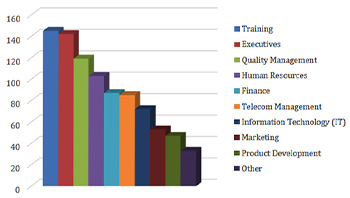
Internal Suppliers to WFM
When ask to identify the departments that serve as internal suppliers to WFM, IT, HR, and training are the most often selected but marketing and product development are well down the list again. With IT supplying the important technologies and HR recruiting and hiring the staff, it is logical for them to be the most frequent suppliers. Marketing and product development are often the drivers of the contact volume and close relationships with these groups can give the center an early warning of spikes and important contact changes to incorporate into the plans. Executives are near the bottom suggesting that while they are receivers of information provided by WFM, they do not have a lot of input.
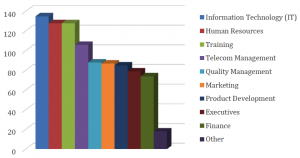
Knowledge in Other Departments
The respondents were asked whether they thought other departments have the right amount of knowledge about WFM to be effective. Only 3 percent strongly agree that they have the knowledge while 40 percent somewhat agree. However, 32 percent somewhat disagree and 13 percent strongly disagree.
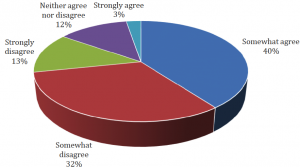
Communications Methods
Respondents were asked how they communicate with other departments and were able to choose multiple answers. Email was chosen by nearly all the participants in the survey with conference calls and in-person meetings following. In some cases, the communication method will be driven by the locations of the parties so that those in single-site operations may be more likely to have an in-person meeting than those in multi-site operations.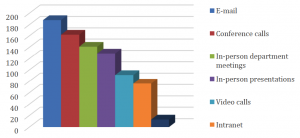
Frequency of Communication
Respondents were asked how often they communicate with other business units. Nearly half (48%) indicated that they communicate more than once a day with another 8 percent indicating it is a daily process. There is probably some variation in the frequency depending upon the business unit. For example, daily interaction with IT or training may be necessary while executive interactions might be less frequent.
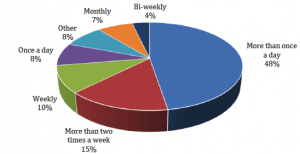
Information Shared
Respondents asked what information is shared during communications with other business units and multiple selections were allowed. The most frequent selection was service level with forecasts for future periods and training dates/requirements close behind. This tracks with the perception in most centers that service level is the most important measure of customer satisfaction and that having the right number of trained personnel in place for a forecast workload is the best way to achieve it.
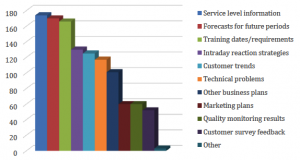
Most Misunderstood WFM Concepts
Respondents were asked what WFM concepts they perceive are the most misunderstood by other business units. Schedule adherence impact was the top choice, followed by the impact of responding to unplanned workload. Only about a quarter of the respondents indicated that the role of the contact center in the organization’s success was an issue. It is often through communication of the impact of the center on the overall business, its customer, and the bottom line that centers find access to the resources needed to be successful.
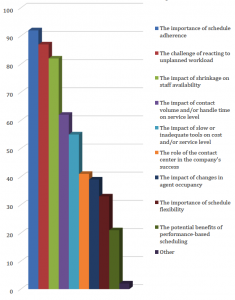
Most Successful Teaching Example Used
When asked to identify the most successful teaching example that had been used to communicate with other business units, the free-form answers vary widely. Some of the most frequent responses include:
- Power of One concepts (most cited by far)
- The impact of marketing efforts and the need to coordinate them with the center to achieve good results for both
- Converting % adherence to minutes lost per period and dollar impact
- Forecast and planned coverage versus the impact of an unplanned surge
- Hiring the wrong fit is worse than having an open position
- Flexible scheduling impact on hiring plans and total head count requirements
- Importance of schedule adherence to adjust to unforeseen volume changes
- Impacts of shrinkage
Closing Comments
Based on the responses above, communications between WFM and other business units presents an opportunity for improvement. Better understanding of the impact each member of the “village” has on the other members is important to overall organization success. Ensuring that the communication includes not only the situation as it is but also the steps needed to achieve better results working together appears to be a significant opportunity.
Each quarter SWPP surveys the workforce planning community on critical workforce planning topics. Almost 200 call center professionals representing a wide variety of industries participated and provided insight into this quarter’s survey on WFM department communications with other business units in the organization.
Survey Participants
Forty-five percent of the respondents in this survey work in centers with over 500 agents. The rest are representative of a wide variety of sizes from under 50 up to 500 agents. The financial, insurance, and “other” industries drew the largest number of participants, but all other industries are also well represented.
Internal Customers of WFM
Respondents were asked which business units in their organization are considered internal customers of WFM and multiple answers were allowed. Training and executives were the most frequently chosen with quality management and HR next. It is interesting to see marketing and product development at the bottom end of the selections. These departments can typically gain significantly from the customer feedback gathered in the contact center and are often more willing to work with the center in planning their communications with customers when they are well informed.
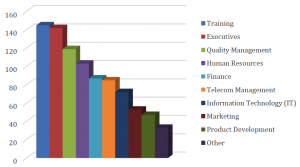
Internal Suppliers to WFM
When ask to identify the departments that serve as internal suppliers to WFM, IT, HR, and training are the most often selected but marketing and product development are well down the list again. With IT supplying the important technologies and HR recruiting and hiring the staff, it is logical for them to be the most frequent suppliers. Marketing and product development are often the drivers of the contact volume and close relationships with these groups can give the center an early warning of spikes and important contact changes to incorporate into the plans. Executives are near the bottom suggesting that while they are receivers of information provided by WFM, they do not have a lot of input.

Knowledge in Other Departments
The respondents were asked whether they thought other departments have the right amount of knowledge about WFM to be effective. Only 3 percent strongly agree that they have the knowledge while 40 percent somewhat agree. However, 32 percent somewhat disagree and 13 percent strongly disagree.

Communications Methods
Respondents were asked how they communicate with other departments and were able to choose multiple answers. Email was chosen by nearly all the participants in the survey with conference calls and in-person meetings following. In some cases, the communication method will be driven by the locations of the parties so that those in single-site operations may be more likely to have an in-person meeting than those in multi-site operations.
Frequency of Communication
Respondents were asked how often they communicate with other business units. Nearly half (48%) indicated that they communicate more than once a day with another 8 percent indicating it is a daily process. There is probably some variation in the frequency depending upon the business unit. For example, daily interaction with IT or training may be necessary while executive interactions might be less frequent.

Information Shared
Respondents asked what information is shared during communications with other business units and multiple selections were allowed. The most frequent selection was service level with forecasts for future periods and training dates/requirements close behind. This tracks with the perception in most centers that service level is the most important measure of customer satisfaction and that having the right number of trained personnel in place for a forecast workload is the best way to achieve it.

Most Misunderstood WFM Concepts
Respondents were asked what WFM concepts they perceive are the most misunderstood by other business units. Schedule adherence impact was the top choice, followed by the impact of responding to unplanned workload. Only about a quarter of the respondents indicated that the role of the contact center in the organization’s success was an issue. It is often through communication of the impact of the center on the overall business, its customer, and the bottom line that centers find access to the resources needed to be successful.

Most Successful Teaching Example Used
When asked to identify the most successful teaching example that had been used to communicate with other business units, the free-form answers vary widely. Some of the most frequent responses include:
- Power of One concepts (most cited by far)
- The impact of marketing efforts and the need to coordinate them with the center to achieve good results for both
- Converting % adherence to minutes lost per period and dollar impact
- Forecast and planned coverage versus the impact of an unplanned surge
- Hiring the wrong fit is worse than having an open position
- Flexible scheduling impact on hiring plans and total head count requirements
- Importance of schedule adherence to adjust to unforeseen volume changes
- Impacts of shrinkage
Closing Comments
Based on the responses above, communications between WFM and other business units presents an opportunity for improvement. Better understanding of the impact each member of the “village” has on the other members is important to overall organization success. Ensuring that the communication includes not only the situation as it is but also the steps needed to achieve better results working together appears to be a significant opportunity.
